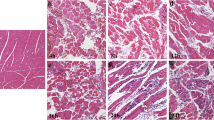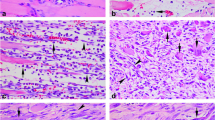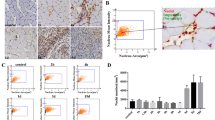Abstract
Although many time-dependent parameters involved in wound healing have been exhaustively investigated, establishing an objective and reliable means for estimating wound age remains a challenge. In this study, 78 Sprague–Dawley rats were divided randomly into a control group and contusion groups at 4, 8, 12, 16, 20, 24, 28, 32, 36, 40, 44, and 48 h post-injury (n = 6 per group). The expression of 35 wound healing–related genes was explored in contused skeletal muscle by real-time polymerase chain reaction. Differences between the groups were assessed by partial least squares discriminant analysis (PLS-DA). The results show that the samples were classified into three groups by wound age (4–12, 16–24, and 28–48 h). A Fisher discriminant analysis model of 14 selected genes was constructed, and 94.9% cross-validated grouped cases were correctly classified. A PLS regression analysis using 14 genes showed reasonable internal predictive validity, with a root mean squared error of cross-validation of approximately 8 h. To examine whether the prediction models were capable of analyzing new (ungrouped) cases, an external validation was carried out using the expression data from an additional 30 rats. Approximately 76.7% of ungrouped cases were correctly classified, which was a lower proportion than that for cross-validation. Similarly, the prediction results of the PLS model showed lower relatively external predictive validity (root mean squared error of prediction = 11 h) than internal predictive validity. Although the prediction results were less accurate than expected, the gene expression modeling and multivariate analyses showed great potential for estimating injury time. These multivariate methods may be valuable when devising future wound time estimation strategies.




Similar content being viewed by others
References
Wang L-L, Zhao R, Liu C-S, Liu M, Li S-S, Li J-Y, Jiang S-K, Zhang M, Tian Z-L, Wang M, Zhang M-Z, Guan D-W (2016) A fundamental study on the dynamics of multiple biomarkers in mouse excisional wounds for wound age estimation. J Forensic Legal Med 39:138–146. https://doi.org/10.1016/j.jflm.2016.01.027
Ishida Y, Kuninaka Y, Nosaka M, Kimura A, Kawaguchi T, Hama M, Sakamoto S, Shinozaki K, Eisenmenger W, Kondo T (2015) Immunohistochemical analysis on MMP-2 and MMP-9 for wound age determination. Int J Legal Med 129(5):1043–1048. https://doi.org/10.1007/s00414-015-1167-5
Yagi Y, Murase T, Kagawa S, Tsuruya S, Nakahara A, Yamamoto T, Umehara T, Ikematsu K (2016) Immunohistochemical detection of CD14 and combined assessment with CD32B and CD68 for wound age estimation. Forensic Sci Int 262:113–120. https://doi.org/10.1016/j.forsciint.2016.02.031
Sun JH, Zhu XY, Dong TN, Zhang XH, Liu QQ, Li SQ, Du QX (2017) An “up, no change, or down” system: time-dependent expression of mRNAs in contused skeletal muscle of rats used for wound age estimation. Forensic Sci Int 272:104–110. https://doi.org/10.1016/j.forsciint.2017.01.012
Palagummi S, Harbison S, Fleming R (2014) A time-course analysis of mRNA expression during injury healing in human dermal injuries. Int J Legal Med 128(3):403–414. https://doi.org/10.1007/s00414-013-0941-5
Liu R, Sun Q, Hu T, Li L, Nie L, Wang J, Zhou W, Zang H (2018) Multi-parameters monitoring during traditional Chinese medicine concentration process with near infrared spectroscopy and chemometrics. Spectrochim Acta A Mol Biomol Spectrosc 192:75–81. https://doi.org/10.1016/j.saa.2017.10.068
Rathore AS, Bhambure R, Ghare V (2010) Process analytical technology (PAT) for biopharmaceutical products. Anal Bioanal Chem 398(1):137–154. https://doi.org/10.1007/s00216-010-3781-x
Zhu X-y, Du Q-x, Li S-q, Sun J-h (2016) Comparison of the homogeneity of mRNAs encoding SFRP5, FZD4, and Fosl1 in post-injury intervals: subcellular localization of markers may influence wound age estimation. J Forensic Legal Med 43:90–96. https://doi.org/10.1016/j.jflm.2016.07.013
Sun JH, Nan LH, Gao CR, Wang YY (2012) Validation of reference genes for estimating wound age in contused rat skeletal muscle by quantitative real-time PCR. Int J Legal Med 126(1):113–120. https://doi.org/10.1007/s00414-011-0604-3
Hassan Gaballah M, Fukuta M, Maeno Y, Seko-Nakamura Y, Monma-Ohtaki J, Shibata Y, Kato H, Aoki Y, Takamiya M (2016) Simultaneous time course analysis of multiple markers based on DNA microarray in incised wound in skeletal muscle for wound aging. Forensic Sci Int 266:357–368. https://doi.org/10.1016/j.forsciint.2016.06.027
Kimura A, Ishida Y, Nosaka M, Shiraki M, Hama M, Kawaguchi T, Kuninaka Y, Shimada E, Yamamoto H, Takayasu T, Kondo T (2015) Autophagy in skin wounds: a novel marker for vital reactions. Int J Legal Med 129(3):537–541. https://doi.org/10.1007/s00414-015-1168-4
van de Goot FR, Korkmaz HI, Fronczek J, Witte BI, Visser R, Ulrich MM, Begieneman MP, Rozendaal L, Krijnen PA, Niessen HW (2014) A new method to determine wound age in early vital skin injuries: a probability scoring system using expression levels of fibronectin, CD62p and factor VIII in wound hemorrhage. Forensic Sci Int 244:128–135. https://doi.org/10.1016/j.forsciint.2014.08.015
Wang Y, Yamamoto Y, Kuninaka Y, Kondo T, Furukawa F (2015) Forensic potential of MMPs and CC chemokines for wound age determination. J Forensic Sci 60(6):1511–1515. https://doi.org/10.1111/1556-4029.12831
Kubo H, Hayashi T, Ago K, Ago M, Kanekura T, Ogata M (2014) Temporal expression of wound-healing-related genes in skin burn injury. Legal Med 16(1):8–13. https://doi.org/10.1016/j.legalmed.2013.10.002
Ibrahim SF, Issak M, Bayoumy AA, Abd El-Fatah DS (2016) Cutaneous (tPA) and skeletal (TnI) mRNA as markers of aging in contused wound. J Forensic Sci 61(4):1007–1010. https://doi.org/10.1111/1556-4029.13072
Zheng JL, Yu TS, Li XN, Fan YY, Ma WX, Du Y, Zhao R, Guan DW (2012) Cannabinoid receptor type 2 is time-dependently expressed during skin wound healing in mice. Int J Legal Med 126(5):807–814. https://doi.org/10.1007/s00414-012-0741-3
Fan YY, Zhang ST, Yu LS, Ye GH, Lin KZ, Wu SZ, Dong MW, Han JG, Feng XP, Li XB (2014) The time-dependent expression of alpha7nAChR during skeletal muscle wound healing in rats. Int J Legal Med 128(5):779–786. https://doi.org/10.1007/s00414-014-1001-5
Tian ZL, Jiang SK, Zhang M, Wang M, Li JY, Zhao R, Wang LL, Li SS, Liu M, Zhang MZ, Guan DW (2016) Detection of satellite cells during skeletal muscle wound healing in rats: time-dependent expressions of Pax7 and MyoD in relation to wound age. Int J Legal Med 130(1):163–172. https://doi.org/10.1007/s00414-015-1251-x
Fronczek J, Lulf R, Korkmaz HI, Witte BI, van de Goot FR, Begieneman MP, Schalkwijk CG, Krijnen PA, Rozendaal L, Niessen HW, Reijnders UJ (2015) Analysis of inflammatory cells and mediators in skin wound biopsies to determine wound age in living subjects in forensic medicine. Forensic Sci Int 247:7–13. https://doi.org/10.1016/j.forsciint.2014.11.014
Takamiya M, Fujita S, Saigusa K, Aoki Y (2007) Simultaneous detections of 27 cytokines during cerebral wound healing by multiplexed bead-based immunoassay for wound age estimation. J Neurotrauma 24(12):1833–1844. https://doi.org/10.1089/neu.2007.0336
Li N, Du Q, Bai R, Sun J (2018) Vitality and wound-age estimation in forensic pathology: review and future prospects. FSR 1–10. https://doi.org/10.1080/20961790.2018.1445441
Casse JM, Martrille L, Vignaud JM, Gauchotte G (2016) Skin wounds vitality markers in forensic pathology: an updated review. Med Sci Law 56(2):128–137. https://doi.org/10.1177/0025802415590175
Kondo T, Ishida Y (2010) Molecular pathology of wound healing. Forensic Sci Int 203(1–3):93–98. https://doi.org/10.1016/j.forsciint.2010.07.004
Kondo T (2007) Timing of skin wounds. Legal Med 9(2):109–114. https://doi.org/10.1016/j.legalmed.2006.11.009
Sun J-h, Wang Y-y, Zhang L, Gao C-r, Zhang L-z, Guo Z (2009) Time-dependent expression of skeletal muscle troponin I mRNA in the contused skeletal muscle of rats: a possible marker for wound age estimation. Int J Legal Med 124(1):27–33. https://doi.org/10.1007/s00414-009-0323-1
Fisher BD, Baracos VE, Shnitka TK, Mendryk SW, Reid DC (1990) Ultrastructural events following acute muscle trauma. Med Sci Sports Exerc 22(2):185–193
Papadimitriou JM, Robertson TA, Mitchell CA, Grounds MD (1990) The process of new plasmalemma formation in focally injured skeletal muscle fibers. J Struct Biol 103(2):124–134
Chen Y, Wang H, Zhang J, Garty G, Simaan N, Yao YL, Brenner DJ (2012) Automated recognition of robotic manipulation failures in high-throughput biodosimetry tool. Expert Syst Appl 39(10):9602–9611
Toziou PM, Barmpalexis P, Boukouvala P, Verghese S, Nikolakakis I (2018) Quantification of live lactobacillus acidophilus in mixed populations of live and killed by application of attenuated reflection Fourier transform infrared spectroscopy combined with chemometrics. J Pharm Biomed Anal 154:16–22. https://doi.org/10.1016/j.jpba.2018.03.009
Funding
This project is financially supported by grants from the National Natural Science Foundation of China (grant numbers 81601646, 81571852).
Author information
Authors and Affiliations
Corresponding authors
Ethics declarations
Conflict of interest
The authors declare that they have no conflict of interest.
Ethical approval
This article does not contain any studies with human participants performed by any of the authors. The principles of the Guide for the Care and Use of Laboratory Animals protocol, published by the Ministry of the People’s Republic of China, were followed.
Additional information
Publisher’s Note
Springer Nature remains neutral with regard to jurisdictional claims in published maps and institutional affiliations.
Electronic supplementary material
ESM 1
(DOCX 28 kb)
Rights and permissions
About this article
Cite this article
Du, Qx., Li, N., Dang, Lh. et al. Temporal expression of wound healing–related genes inform wound age estimation in rats after a skeletal muscle contusion: a multivariate statistical model analysis. Int J Legal Med 134, 273–282 (2020). https://doi.org/10.1007/s00414-018-01990-2
Received:
Accepted:
Published:
Issue Date:
DOI: https://doi.org/10.1007/s00414-018-01990-2




